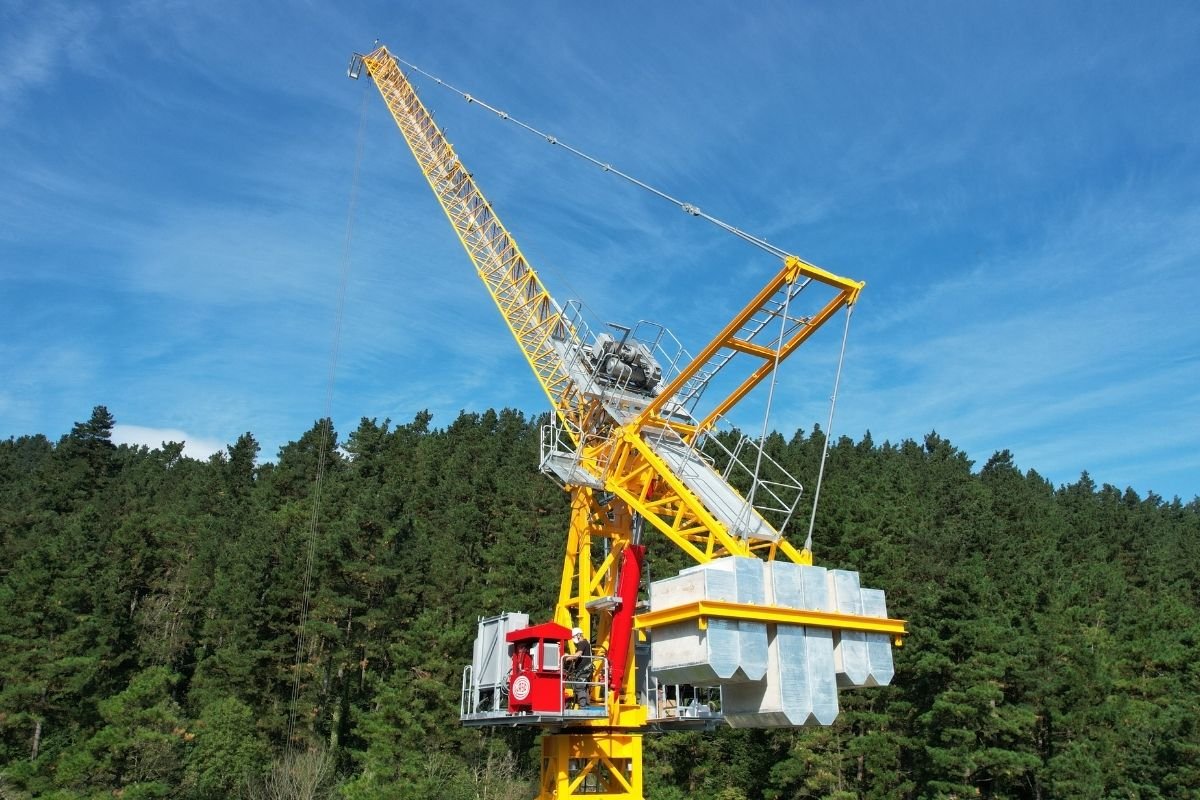JASO Launches First 18t Capacity Hydraulic Luffer: the J198HPA

28 / 10 / 2021
This hydraulic luffing crane is one of the largest on the market, and the largest in terms of load capacity.
Initially, the project was envisioned as a restyling of the J168HPA, launched in 2014 and which marked a turning point for the hydraulic crane market. Finally, a thorough redesign was chosen, and this model was developed as part of the medium range of luffing cranes (200-350tm). With its 18t capacity, the J198HPA is the largest crane in terms of maximum load and one of the largest on the market aimed at urban projects or high-rise projects in cramped inner-city sites.
The J198HPA has a maximum capacity of 18t in 3-part line, and a tip load of 1.6t at 55m. This crane can also run in Direct Pull only with a special Slim Line hook block, to achieve 1.8t load at 55m, and a maximum load of 6t. In addition, it provides multiple load chart options, boom lengths and maximum loads of 8t, 10t and 12t in 2-part line. Switching between the various configurations can be easily done on site.
New Design, More JASO Than Ever
As usual on JASO hydraulic luffing cranes, the hydraulic ram is kept at the rear end of the tower. In this way, when the crane is out of service, the piston is fully retracted in the ram’s strongest position, ensuring longer life to the ram.
Its fully optimized boom starts at 30m and can be increased in 5-metre increments to a maximum jib length of 55m and a minimum Out-Of-Service radius (OOS) of 8 meter.
Special attention has been paid to improving the assembly process, which is easy, simple, safe and extremely fast thanks to weight optimization and to the optimized pre-assembly.
In this new model, the hydraulic ram is completely pre-installed at the factory. It is part of a single, very compact assembly, consisting of the slew turret, tower head, and jib pivot foot, with pre-installed mechanisms, using quick connectors, on both the electrical and hydraulic parts.
As a result of weight optimization, the tower head/slewing table is the heaviest part, with a total weight of 12.1t. When there are access limitations for auxiliary equipment, the assembly process can be adaptable, thus reducing the component weight down to 6.8t.
The optimization also has an impact on transport, as the upper part of the crane can be transported in 3 trucks. In other words, only 5 trucks are required to ship the entire crane up to its self-supporting height.
The hoist winch has been integrated into the boom, which allows to run the ropes on the ground, thus speeding up the processes of erecting and dismantling the crane, and adding to the safety of the process.
In addition, all platforms, as well as the handrails, are preinstalled and foldable, providing a cleaner design. All accesses are optimized and, among other advantages, it is no longer necessary to use a safety harness to access control cabinets and main access points.
Swing radius with concrete or optional steel-framed concrete counterweights is 8.2 m. With steel counterweights, the radius can be reduced to 7.9m and it can also be transported pre-assembled for a safer and faster assembly.
This model, using a standard 1.75 x 1.75 m tower system with 12, 6 and 3 m long sections, can reach a free-standing height of 38.1 m, while much greater heights can be achieved when combined with 2.16 x 2.16 m tower systems. In addition, for internal climbing applications, this crane can be mounted on 1.87m system towers, which gives a considerable advantage over other similar size cranes.
Two types of cruciform bases of 4.5 x 4.5 m and 6 x 6 m are available, giving a maximum free-standing heights of 38.9 m and 44.8 m respectively with a 30-metre boom.
The J198HPA comes with a 45kW hoist winch that provides a maximum speed of 154m/min, and an optional 65kW winch for an extremely fast speed of 227m/min. Hoist drum can be specified with Lebus grooving and an optional secondary brake.
Energy-Saving Modes and Other Advantages
The crane is equipped with the ECO Mode system. This system allows the crane to operate in three modes:
- Full Power
- ECO Mode, which reduces energy consumption by 25%
- SUPER-ECO Mode, which reduces energy consumption by up to 50%
Thanks to this system, it is possible to use a bigger hoist motor, reducing its power consumption on sites with restricted power supply —without affecting the downward speed.
In addition, we could highlight the following advantages:
- Moment and overload functions controlled by the LMI and redundantly by electromechanical limiters
- Malfunctioning on the hoisting and luffing movements, such as overspeed and reverse speed, are controlled by safety encoders, located on the drum shaft
- Reliable diagnosis of breakdowns in the LMI of the cabin and the black box
- Quick set up of the crane limiters made from the cabin
- Load leveling system
- Possibility of leaving the crane in Out-Of-Service (OOS) in case of loss of electrical power
- Mechanisms with frequency converter and potentiometer also in the slewing movement
All these features make the new J198HPA a hydraulic luffing crane that lives up to its expectations.
